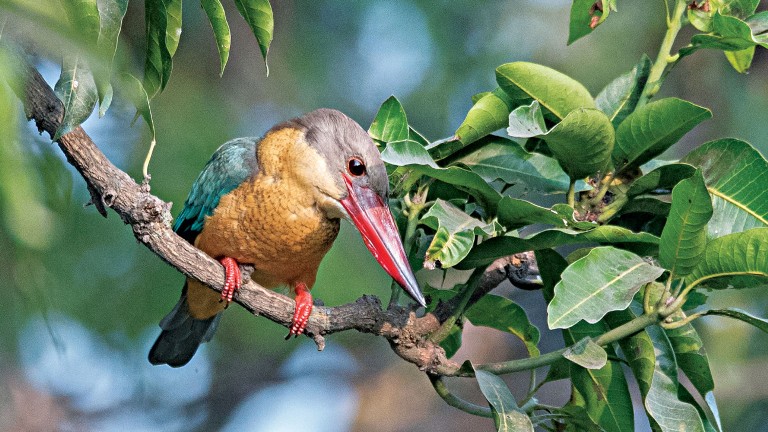
Birdwatchers are often called 'birders.' In the older days, they were easily spotted by their binoculars and reference books but lately, cameras have almost completely replaced binoculars and taking pictures has become a priority for many. COURTESY
Do you ever wish that you were a bird so you could just fly away? Free from all your problems? Since that's not possible, we might as well settle for watching our avian friends fly. The idea of birdwatching is not new, but it's not as popular in Bangladesh as it could be, given our rich biodiversity.
That's just one little part of it. Birdwatching involves identifying, cataloguing, learning, researching about birds, their nature and habitats. And the best part of it is that you get to see the birds in their natural setting and once you learn about their nature, you get to truly appreciate the beauty of it.
Birdwatchers are often called 'birders.' In the older days, they were easily spotted by their binoculars and reference books but lately, cameras have almost completely replaced binoculars and taking pictures has become a priority for many.
Ardent birders are not very fond of the trend where you must take a picture. Sometimes, the best thing to do is to just observe from a distance, but they also recognise the advantages of modern cameras. Taking photos and identifying birds is much easier these days, which is good news since it means cataloguing has become easier.
The experience
It's one of the most challenging hobbies, yet most rewarding at the same time. Naser Ahmed, an avid birdwatcher and photographer outlined all the facts of birdwatching while reminiscing about some of his most exciting adventures in search of birds.
"It's physically exhausting. Often you have to be on the road for hours and days at a time, then camp for a few hours when you barely get any rest and rush to the point of interest in search of the birds. When you get back home after a few days, you are physically drained, but it's completely worth it when you get to see all the colourful birds and how they dance about in nature."
Birdwatching often involves heavy reliance on your auditory senses, as many bird species are more easily detected and identified by ears than by eyes. Many birds are too shy and would hide in vegetation and it could be difficult to identify them by sight. This might seem a bit frustrating at first since you have to wait for hours at the same spot and still you might not catch a glimpse of the bird you are looking for but for the vehement birder, it's a challenge that is welcomed. Once you understand and study the nature and habitat of the birds, you will learn to respect their privacy and need for space.
The biodiversity
People living in Dhaka meet one particular species of bird on a regular basis — crows. But there are so much more out there should you be interested.
"A total of 718 species of birds have been recorded in Bangladesh. About 338 birders have logged 620 species on eBird, an online database of bird observations that provides real-time data. Of the 620, 387 species are recorded for Dhaka division," added Naser Ahmed, insisting on the importance of database and cataloguing.
When asked about his three most favourite species, he was hesitant because there are so many amazing birds to choose from. But eventually he picked Asian Paradise Flycatcher, Indian Pitta and Velvet-fronted Nuthatch. All three are native to Bangladesh.
The hotspots
There are countless hotspots scattered all across Bangladesh that are home to hundreds of birds, from Tetulia to Teknaf. However, the prime locations include several forests in Sylhet Division; the area covering Chattogram Hill Tracts to the Sundarbans, with the entire coastal belt in between, and Rajshahi, particularly the Padma char areas. The Botanical Gardens, Aftabnagar, Purbachal, Keraniganj, Bashundhara and Jahangirnagar University campus are some of the key hotspots around Dhaka. This winter will be an ideal time for birdwatching, when both native and migratory birds may be sighted.
There is, however, an issue that keeps growing worse with each passing day; how these bird habitats in Dhaka are being rapidly taken over by the housing projects. Locations like Purbachal and Bashundhara used to be safe haven for birds and birders were having field days even a few years ago, but with the completion of the development projects in those locations, bird sighting has become rare as they keep losing their abode.
Aftabnagar and Keraniganj are the latest locations that illustrate this disturbing fact and if we are not careful about it, Dhaka will lose its biodiversity sooner than we can imagine.
To the beginners
It is important to learn about the birds and, their nesting styles. Birds in Bangladesh are more frightened than the average birds and this means that birders have to be more careful not to scare them off, especially during the breeding seasons. Split up into smaller groups rather than large gatherings so not to disturb the birds. Since photography has become an important part of birding, learning the basics of handling a camera is also a good idea. Learning how to document a bird sighting is crucial and can be helpful for a potential mapping attempt in the future. More importantly, being part of a community could be very helpful for the beginners and new blood is always welcomed because of their raw passion.






0 Comments